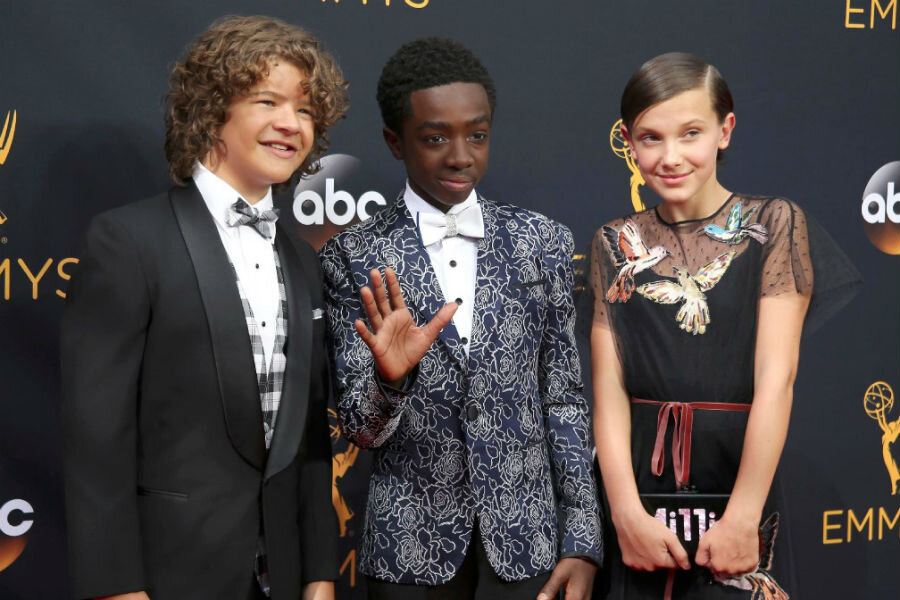Netflix pushes for '50 percent original content.' Will we subscribe?
Loading...
Netflix will double down on its original content, aiming to produce 50 percent of its own programming over the next few years, according to Netflix chief financial officer David Wells.
The company, which started out distributing DVDs by mail and later developed a streaming service for licensed content, has over the last few years evolved into a producer of original movies and TV shows. Shows like “House of Cards” have been critically acclaimed, winning Emmys, Golden Globes, and the Screen Actors Guild awards.
The US entertainment market is fiercely competitive, as Mr. Wells noted on a conference call with Goldman Sachs on Tuesday. Streaming services like Hulu and Amazon Prime, as well as emerging alternatives Showtime and Disney, offer subscribers a plethora of options on which to spend their dollars. So how can Netflix hold onto subscribers – and attract new ones? In part, by offering them something they can’t get elsewhere: acclaimed original programming.
“The idea is that people who want Netflix for the movies and the old shows … by now, have subscribed. But, with new original programming, every time it comes out, it gets promoted.… Each original program wears away at the resistance of those people who have not subscribed yet,” Robert Thompson, the director of the Bleier Center for Television and Popular Culture at Syracuse University, tells The Christian Science Monitor in a phone interview.
He says that those who are currently Netflix subscription holdouts are eventually “going to hear of an original show that they really want to see.” And because Netflix has control of the content, viewers have to subscribe to the service to be able to watch any given show.
Dr. Thompson cites his own case as an illustrative one, having somehow avoided subscribing until “House of Cards” came out. He finally got Netflix because of the buzz the show was generating, and its critical acclaim at the Emmy Awards. After that, as he puts it, he “will never go through the trouble to unsubscribe.”
Precisely because Netflix is a subscriber service, there’s less pressure from the company’s bottom line for all its original shows to be hits. Unlike broadcast TV, where the number of viewers determines income, Netflix doesn’t need all its viewers to be watching their content. It’s a question of providing the value that grows the subscriber base, and then keeping viewers engaged enough not to cancel the service. For that reason, the blend of original and licensed content has so far been a winning one for Netflix.
A single original show may add millions of subscribers. One possible case in point: “Fuller House.” During the first quarter of 2016, when “Fuller House” aired, Netflix gained 6.7 million new subscribers. That’s the highest absolute increase in the past five years.
While it’s impossible to say that any one increase in subscribers is attributable to a given show, original programming is the primary source of Netflix’s “absolutely extraordinary success,” Paul Levinson, a professor of communications and media at Fordham University in New York, tells The Christian Science Monitor in a phone interview.
How will Netflix finance the increase in original programming? The company expects to spend an a total of $6 billion on content (both original and licensed) in 2017, a $1 billion increase from 2016. Advertising is not on the table at this point, according to Netflix CFO Mr. Wells. He told the audience of Goldman Sachs’ Communacopia conference that “there’s no immediate plans for an ad-supported product … The Netflix brand stands for no advertising.”
That means subscription costs would likely go up, possibly putting pressure on some customers to cancel the service. But “Netflix, I think, is one of those services right now that many people really think that they need,” explains Thompson, who describes it as “an indispensable” as necessary as food or housing. He says this is particularly true of so-called “cord cutters” who don’t have cable and may be more reliant on Netflix as a source of quality programming.
The push for original content isn’t just for Netflix’s English-speaking subscribers, either. The company recently rolled out plans to produce shows in Poland, as part of a push to win subscribers in one of the region's most populous countries. Dr. Levinson expects much more localized programming to follow, as the company creates content that can engage viewers internationally.
What does Netflix’s diversification mean for television? Levinson flags up an almost symbiotic relationship between the two: "A show like 'Madam Secretary' is the result of 'House of Cards.'" And Netflix’s push for original content has also pushed traditional media to spend more on original programming, according to Bloomberg.
That may be a win for viewers, who now have more choice in the original content they choose to watch. Levinson, however, says that original content is not an area where broadcast television, at least, can hope to compete: "I don’t think they’re ever going to catch up." TV may have an edge in news programming and breaking news, since people look for that kind of programming in traditional sources.
"This is the spearhead of the current revolution in television … it’s basically Netflix and Amazon," Levinson concluded.








